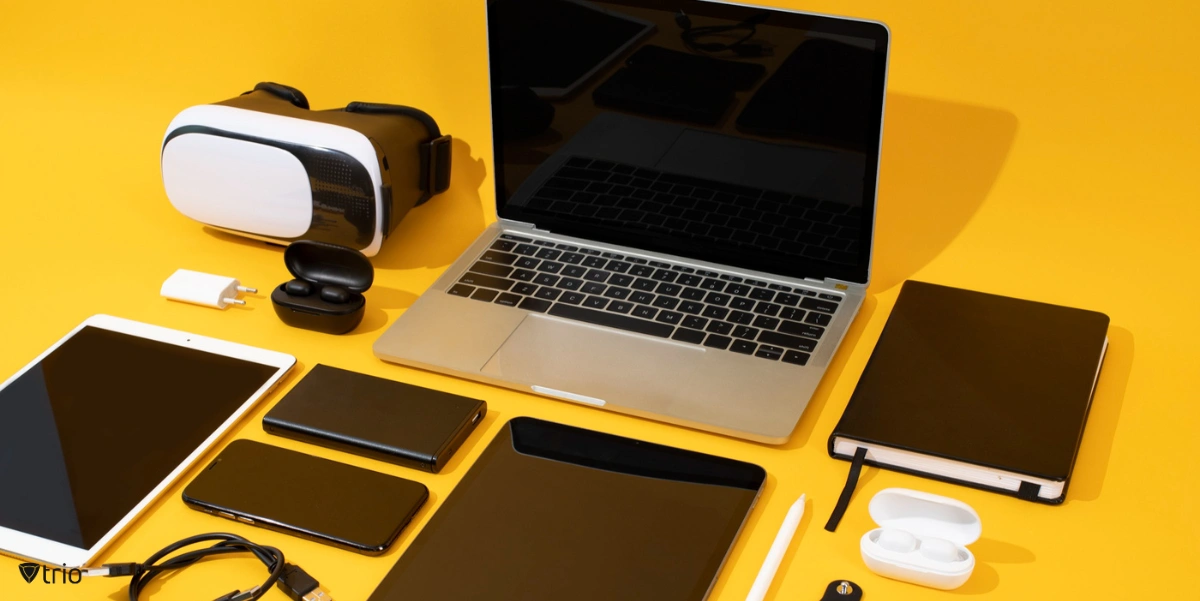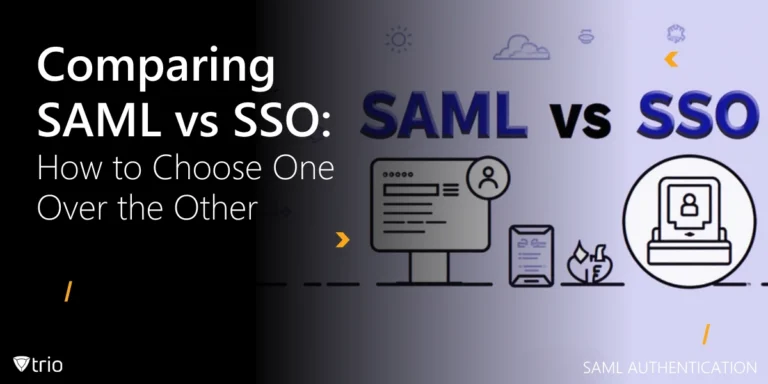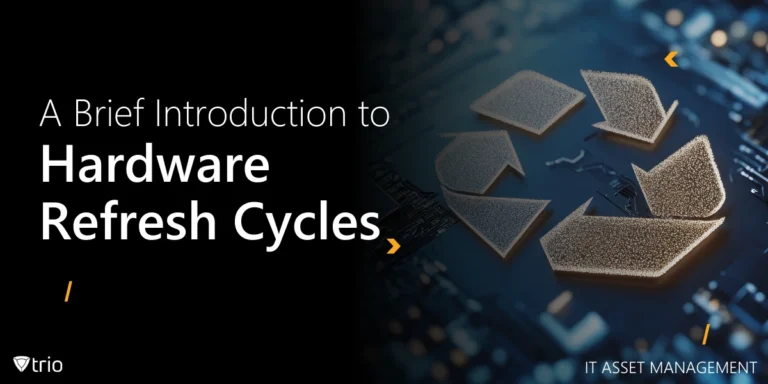In today’s era of remote work, understanding and implementing Device Lifecycle Management (DLM) is more critical than ever. This blog post delves into the essence of DLM, guiding organizations through the nuanced process of managing devices from procurement to disposal, ensuring operational efficiency, security, and cost-effectiveness.
Understanding Device Lifecycle Management (DLM)
Device Lifecycle Management (DLM) is a comprehensive approach that encompasses the entire lifespan of a device in an organization. This process includes several key stages that are briefly explained in the next section. At the core, DLM ensures that every piece of equipment is efficiently utilized from the moment it is acquired until its final decommissioning. This lifecycle approach not only involves the physical aspects of a device but also includes managing the hardware and software components critical to its operation. Throughout a device’s life, maintaining optimal performance, security, and compliance with relevant regulations is paramount, especially in the face of evolving technology and security threats.
The Stages of Device Lifecycle Management (DLM)
Device Lifecycle Management (DLM) involves several critical stages to ensure devices are efficiently managed from procurement to disposal. Understanding these stages can help organizations and individuals to optimize the use and management of their devices.
-
Planning and Procurement
This initial stage involves assessing the need for devices and planning their acquisition. It includes determining the types and quantities of devices required to meet organizational or personal needs, researching vendors, and purchasing or leasing devices. Effective planning ensures that the procured devices align with the specific requirements and goals.
-
Deployment and Enrollment
Once devices are procured, they need to be prepared for use. This stage includes setting up the devices with necessary configurations, installing software, and enrolling them into Mobile Device Management (MDM) systems if applicable. Device provisioning ensures devices are ready for users with the required tools and settings for optimal performance.
-
Operation and Maintenance
Operational maintenance is crucial for extending the life of devices and ensuring they run efficiently. This stage involves regular software updates, security patches, and managing hardware issues. It’s about keeping the devices in top working condition through proactive monitoring and maintenance, which includes troubleshooting hardware and software issues as they arise.
-
Security Management
Throughout its lifecycle, every device must be protected against potential security threats. Security management includes implementing and updating antivirus software, encryption, and firewalls. It also involves conducting regular security audits and ensuring data protection through strong passwords and access controls. This stage is critical for protecting sensitive information from cyber threats.

-
Upgrade and Replacement
Technology evolves rapidly, and devices may become obsolete or insufficient for current needs. This stage involves deciding whether to upgrade existing devices with new hardware or software or replace them entirely with more advanced models. For organizations, keeping technology up to date is essential for maintaining productivity and meeting evolving requirements.
-
Disposal and Recycling
The final stage of DLM is the responsible disposal or recycling of devices that are no longer needed or functional. This includes securely wiping data to protect privacy and following environmentally friendly disposal practices. Proper end-of-life management ensures that devices are decommissioned in a way that minimizes their environmental impact and complies with regulatory requirements.
By meticulously managing each stage of the device lifecycle, organizations can maximize the value and productivity of their technology investments while ensuring security and compliance. This structured approach to DLM supports operational efficiency, cost management, and environmental sustainability.
The Benefits of Effective Device Lifecycle Management
Effective Device Lifecycle Management (DLM) isn’t just about keeping track of gadgets. Let’s take a look at some of the benefits of DLM.
Cost Savings and Budget Optimization
Effective DLM is a strategic approach that leads to significant cost savings and budget optimization. By predicting when devices need upgrades or replacements, organizations can avoid unexpected expenses. This lifecycle management process ensures that every dollar spent is an investment, not just an expense. With DLM, you’re not only managing devices; you’re managing your budget too. Organizations find that maintenance costs decrease, as regular monitoring and updates prevent costly repairs down the line. Device inventory management becomes less of a headache, with a clear view of what’s in stock and what needs updating.
Enhanced Security and Compliance
In today’s digital age, the security risks associated with poorly managed devices can be catastrophic. Effective DLM fortifies device security by ensuring timely software management and compliance with the latest security standards. This process is crucial for mitigating security risks and protecting sensitive data. Regular updates and checks ensure devices are guarded against the latest threats, making your tech fortress impregnable. Plus, adhering to regulatory requirements isn’t just a tick box exercise; it’s about safeguarding your reputation and trust. With DLM, you’re not just securing devices; you’re securing peace of mind for everyone involved.
Mastering the Art of DLM
Mastering the Art of DLM requires a strategic approach to technology management, balancing innovation with sustainability and security.
Smart Picks and Swift Rollouts
Navigating the sea of technology for the perfect set of devices is the first step in a robust equipment lifecycle management strategy. The key? Select gadgets that not only meet today’s needs but also adapt to tomorrow’s challenges. Leveraging MDM tools at this stage transforms the complex choreography of deployment into a streamlined dance. These management processes ensure devices are equipped with the necessary software and settings right out of the gate, making the transition for users as smooth as silk. Remember, the right start paves the way for a journey filled with productivity and efficiency.

Keeping the Engine Running
Regular updates and vigilant monitoring are the unsung heroes in maintaining device performance and security. This phase is where the rubber meets the road in lifecycle management strategy. Managed service solutions take the reins here, automating the deployment of crucial software updates and patches, ensuring that devices aren’t just running, but sprinting ahead with the latest defenses against digital threats. This proactive approach minimizes downtime and keeps security breaches at bay, letting you focus on driving forward rather than looking over your shoulder.
The Graceful Exit
All good things must come to an end, including the lifecycle of a device. End-of-life management and disposal are critical chapters in the story, where security meets responsibility. The aim? To ensure that devices bow out without leaving a trace of sensitive data behind or harming the environment. A well-crafted lifecycle management strategy ensures data loss prevention and incorporates secure data wiping and eco-friendly disposal practices, closing the loop on the device’s journey with integrity and respect for privacy and the planet.
Overcoming Challenges in Device Lifecycle Management
Overcoming challenges in Device Lifecycle Management (DLM), particularly in the face of rapid technological advances and ensuring seamless integration with existing systems, requires a strategic approach and the effective use of Mobile Device Management (MDM) solutions.
Keeping Up With Technology Advances
To stay ahead in a rapidly evolving tech landscape, adopting a proactive stance on hardware lifecycle management is essential. This involves regular assessments of your tech inventory and making informed decisions based on a thorough understanding of the technology lifecycle. By recognizing the stages of technology—from R&D, ascent, maturity, to decline—you can better plan for refreshes and upgrades, ensuring your equipment remains effective and secure. Leveraging insights from technology lifecycle management can guide you in making strategic choices that align with your organization’s growth and investment plans, optimizing functionality, flexibility, and cost-efficiency. Regular monitoring of device usage also plays a critical role, helping you identify when to invest in more advanced solutions to support your team’s productivity and mitigate risks associated with outdated technology.
Integration With Existing Systems
Integrating MDM solutions with your current IT infrastructure smoothly calls for a detailed understanding of both your hardware lifecycle and the sensitive data it contains. It’s crucial to establish clear user profiles and access levels, ensuring employees have the necessary resources without compromising security. Implementing robust access control policies safeguards sensitive information, thereby enhancing overall device security. Moreover, a strategic approach to device maintenance, emphasizing regular updates and security measures like encryption and multi-factor authentication, protects against emerging threats. At the decommissioning stage, prioritizing secure data-wiping protocols and responsible disposal practices ensures the protection of sensitive information and adherence to environmental standards.
By addressing these challenges with strategic planning, regular monitoring, and the integration of comprehensive MDM solutions, organizations can enhance their equipment lifecycle management processes. This approach not only helps in staying abreast of technological advancements but also ensures that the integration with existing systems is seamless and secure, ultimately leading to improved efficiency, security, and ROI on your technology investments.
The Role of MDM in DLM
Mobile Device Management (MDM) plays a pivotal role in facilitating the stages of the mobile device lifecycle management. MDM solutions streamline the complex and often time-consuming tasks associated with managing a fleet of mobile devices. From the initial setup and enrollment of devices to ensuring they are loaded with the correct applications and settings, MDM simplifies deployment. Throughout the operational life of these devices, MDM enables proactive maintenance by automating software updates and managing security settings, thereby reducing downtime and protecting against potential breaches. As devices reach the end of their useful life, MDM assists in the secure and efficient decommissioning of hardware, ensuring sensitive data is wiped and devices are disposed of in an environmentally responsible manner. This life cycle management through MDM ensures that every device is optimized for performance and security throughout its usage, while also easing the transition between old and new equipment.
In the dynamic and fast-paced digital environment, understanding and implementing effective DLM and MDM strategies are crucial for organizations to maintain operational efficiency, enhance security, and manage costs effectively. That’s why we recommend using Trio, our Mobile Device Management app. You can sign up for your free demo today!
Conclusion
As we navigate the complexities of remote work and digital transformation, the insights provided in this blog post on Device Lifecycle Management underscore its indispensable role. By adopting these strategic approaches, organizations can ensure their technology infrastructure remains robust, secure, and aligned with evolving business needs, thereby safeguarding their digital future.
Get Ahead of the Curve
Every organization today needs a solution to automate time-consuming tasks and strengthen security.
Without the right tools, manual processes drain resources and leave gaps in protection. Trio MDM is designed to solve this problem, automating key tasks, boosting security, and ensuring compliance with ease.
Don't let inefficiencies hold you back. Learn how Trio MDM can revolutionize your IT operations or request a free trial today!




